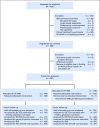Three-Year Outcomes With Hypofractionated Versus Conventionally Fractionated Whole-Breast Irradiation: Results of a Randomized, Noninferiority Clinical Trial
- PMID: 30379626
- PMCID: PMC6286164
- DOI: 10.1200/JCO.18.00317
Three-Year Outcomes With Hypofractionated Versus Conventionally Fractionated Whole-Breast Irradiation: Results of a Randomized, Noninferiority Clinical Trial
Abstract
Purpose: The adoption of hypofractionated whole-breast irradiation (HF-WBI) remains low, in part because of concerns regarding its safety when used with a tumor bed boost or in patients who have received chemotherapy or have large breast size. To address this, we conducted a randomized, multicenter trial to compare conventionally fractionated whole-breast irradiation (CF-WBI; 50 Gy/25 fx + 10 to 14 Gy/5 to 7 fx) with HF-WBI (42.56 Gy/16 fx + 10 to 12.5 Gy/4 to 5 fx).
Patients and methods: From 2011 to 2014, 287 women with stage 0 to II breast cancer were randomly assigned to CF-WBI or HF-WBI, stratified by chemotherapy, margin status, cosmesis, and breast size. The trial was designed to test the hypothesis that HF-WBI is not inferior to CF-WBI with regard to the proportion of patients with adverse cosmetic outcome 3 years after radiation, assessed using the Breast Cancer Treatment Outcomes Scale. Secondary outcomes included photographically assessed cosmesis scored by a three-physician panel and local recurrence-free survival. Analyses were intention to treat.
Results: A total of 286 patients received the protocol-specified radiation dose, 30% received chemotherapy, and 36.9% had large breast size. Baseline characteristics were well balanced. Median follow-up was 4.1 years. Three-year adverse cosmetic outcome was 5.4% lower with HF-WBI ( Pnoninferiority = .002; absolute risks were 8.2% [n = 8] with HF-WBI v 13.6% [n = 15] with CF-WBI). For those treated with chemotherapy, adverse cosmetic outcome was higher by 4.1% (90% upper confidence limit, 15.0%) with HF-WBI than with CF-WBI; for large breast size, adverse cosmetic outcome was 18.6% lower (90% upper confidence limit, -8.0%) with HF-WBI. Poor or fair photographically assessed cosmesis was noted in 28.8% of CF-WBI patients and 35.4% of HF-WBI patients ( P = .31). Three-year local recurrence-free survival was 99% with both HF-WBI and CF-WBI ( P = .37).
Conclusion: Three years after WBI followed by a tumor bed boost, outcomes with hypofractionation and conventional fractionation are similar. Tumor bed boost, chemotherapy, and larger breast size do not seem to be strong contraindications to HF-WBI.
Figures



References
-
- Whelan TJ, Pignol JP, Levine MN, et al. : Long-term results of hypofractionated radiation therapy for breast cancer. N Engl J Med 362:513-520, 2010 - PubMed
-
- Haviland JS, Owen JR, Dewar JA, et al. : The UK Standardisation of Breast Radiotherapy (START) trials of radiotherapy hypofractionation for treatment of early breast cancer: 10-year follow-up results of two randomised controlled trials. Lancet Oncol 14:1086-1094, 2013 - PubMed
-
- Owen JR, Ashton A, Bliss JM, et al. : Effect of radiotherapy fraction size on tumour control in patients with early-stage breast cancer after local tumour excision: Long-term results of a randomised trial. Lancet Oncol 7:467-471, 2006 - PubMed
-
- Smith BD, Bentzen SM, Correa CR, et al. : Fractionation for whole breast irradiation: An American Society for Radiation Oncology (ASTRO) evidence-based guideline. Int J Radiat Oncol Biol Phys 81:59-68, 2011 - PubMed
-
- American Society for Radiation Oncology: Choosing Wisely. An Initiative of the ABIM Foundation. Ten things physicians and patients should question. http://www.choosingwisely.org/societies/american-society-for-radiation-o...
Grants and funding
LinkOut - more resources
Full Text Sources
Medical
Research Materials
Miscellaneous

